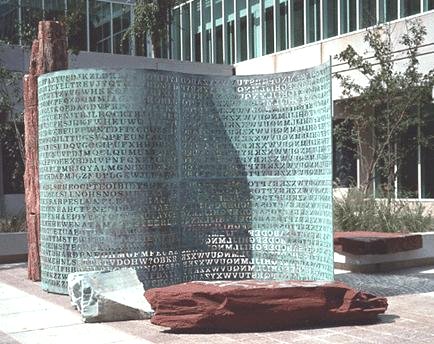Untitled Document

It is one of the world's most baffling puzzles, the bane of professional cryptologists
and amateur sleuths who have spent 15 years trying to solve it.
But the race to find the secrets of Kryptos, a sculpture inside a courtyard at
the CIA's heavily guarded headquarters in Langley, Virginia, may be reaching a
climax.
And interest has soared since Dan Brown hid references to Kryptos on the cover
design for his bestselling novel The Da Vinci Code, and suggested it might play
a role in his next novel, The Solomon Key.
The Kryptos sculpture incorporates a coded message made up of thousands of
letters punched through a nearly 4 meter (12ft) high copper scroll.
Though it was installed where only CIA agents and cryptographers could see
it, amateur code-breakers have worked away on transcripts posted on the CIA's
website.
Three-quarters of the code has been broken, and the deciphered message so far
appears to point to something momentous buried on CIA grounds.
But the clues are obscure and the fourth passage of the Kryptos code - known
as K4 to the addicted - has remained impenetrable.
However, Elonka Dunin, who runs the most comprehensive website on Kryptos (www.elonka.com/kryptos)
said recent activity has surged.
"My baseline was about 500-600 unique visitors a day. But I recently got
30,000 over a 24-hour period," said Ms Dunin, an executive at a Missouri-based
internet game company, Simutronics.
No one is more amazed at the sudden excitement than Kryptos's creator, Jim
Sanborn, who was hired in 1989 by the CIA director at the time, William Webster.
Mr Sanborn worked with a CIA cryptographer, Ed Scheidt, to produce the coded
sculpture, consisting of the S-shaped copper scroll, a petrified tree, a water-filled
basin and stones marked with fragments of Morse code and a compass. Placing
it in the thick of many of the best code-breakers in the world, they never thought
it would take this long.
"These were events I thought would take months not years," Mr Sanborn,
a Washington-based sculptor, told the Guardian.
The references to Kryptos on the jacket of The Da Vinci Code were only spotted
recently. Now Mr Sanborn is worried that the religious and spiritual overtones
of Brown's books could settle on his sculpture.
"Somehow I've been drawn into that vortex," he said.
With that in mind, Mr Sanborn is taking precautions.
"I have taken all Kryptos-related material from my house and studio,"
he said. "The crypto' world has its share of crazies."
It took eight years for the first three Kryptos passages to be cracked, by
a CIA officer named David Stein, after a total of 400 hours with pen and paper.
He was hit, he later wrote "by that sweetly ecstatic, rare experience
that I have heard described as a 'moment of clarity'."
This being the CIA, the solution was kept a secret, but it was solved separately
by Jim Gillogly, a California computer scientist, who published the first three
passages in 1999.
They both used the same method, relying on the fact that the English language
uses letters with varying frequencies, allowing code-breakers to calculate which
ciphers represent which letters.
The fourth passage has been masked to make that impossible. So far, Mr Gillogly,
one of America's best cryptologists, says he has spent "a couple of hundred
hours spread over six years" on the 97 remaining letters, with no success.
The solution so far includes a couple of misspellings which Mr Sanborn has
said are deliberate.
It gives the coordinates of a spot which seems to be on CIA grounds, and says
"only WW" knows the exact location, an apparent reference to William
Webster.
It then quotes the diary entry of the archaeologist Howard Carter on finding
Tutankhamen's tomb.
After completing the sculpture, Mr Sanborn had to hand Mr Webster an envelope
containing the solution, but now suggests he gave neither Mr Webster nor Mr
Scheidt, the full story. He insists the fourth passage is decipherable and would
not be surprised if it were solved soon. "It's being barraged right now,"
he said.
Some of the "addicts" are going to remarkable lengths to solve Kryptos.
Gary Phillips, 27, told the Guardian he had abandoned his software company
so that he could devote more time to the code puzzle.
"I can see how some might perceive that I made a sacrifice by closing
my business and pursuing Kryptos," Mr Phillips, a Michigan programmer,
said.
But he added: "Kryptos brought me back to my first love. Like my childhood
programming days, I was once again free to pursue a challenge that didn't have
the limitations of 'this is how to do it'."
Mr Sanborn admits he would feel a tinge of regret if Kryptos is solved. He
said: "All of us should hope it does survive. There are codes in all our
lives that we hope are never deciphered."

